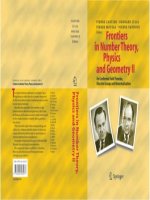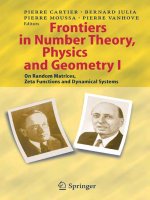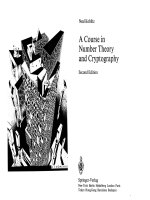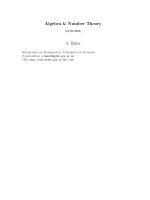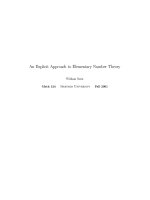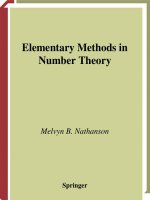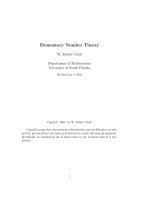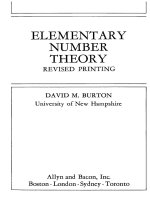elementary number theory and primality tests
Bạn đang xem bản rút gọn của tài liệu. Xem và tải ngay bản đầy đủ của tài liệu tại đây (464.56 KB, 117 trang )
Chapter 1
The Fundamental Theorem of
Arithmetic
1.1 Prime numbers
If a, b ∈ Z we say that a divides b (or is a divisor of b) and we write a | b, if
b = ac
for some c ∈ Z.
Thus −2 | 0 but 0 2.
Definition 1.1 The number p ∈ N is said to be prime if p has just 2 divisors in N,
namely 1 and itself.
Note that our definition excludes 0 (which has an infinity of divisors in N) and
1 (which has just one).
Writing out the prime numbers in increasing order, we obtain the sequence of
primes
2, 3, 5, 7, 11, 13, 17, 19, . . .
which has fascinated mathematicians since the ancient Greeks, and which is the
main object of our study.
Definition 1.2 We denote the nth prime by p
n
.
Thus p
5
= 11, p
100
= 541.
It is convenient to introduce a kind of inverse function to p
n
.
Definition 1.3 If x ∈ R we denote by π(x) the number of primes ≤ x:
π(x) = {p ≤ x : p prime}.
Thus
π(1.3) = 0, π(3.7) = 2.
Evidently π(x) is monotone increasing, but discontinuous with jumps at each
prime x = p.
1–1
374 1–2
Theorem 1.1 (Euclid’s First Theorem) The number of primes is infinite.
Proof Suppose there were only a finite number of primes, say
p
1
, p
2
, . . . , p
n
.
Let
N = p
1
p
2
···p
n
+ 1.
Evidently none of the primes p
1
, . . . , p
n
divides N.
Lemma 1.1 Every natural number n > 1 has at least one prime divisor.
Proof of Lemma The smallest divisor d > 1 of n must be prime. For otherwise
d would have a divisor e with 1 < e < d; and e would be a divisor of n smaller
than d.
By the lemma, N has a prime factor p, which differs from p
1
, . . . , p
n
.
Our argument not only shows that there are an infinity of primes; it shows that
p
n
< 2
2
n
;
a very feeble bound, but our own. To see this, we argue by induction. Our proof
shows that
p
n+1
≤ p
1
p
2
···p
n
+ 1.
But now, by our inductive hypothesis,
p
1
< 2
2
1
, p
2
< 2
2
2
, . . . , p
n
< 2
2
n
.
It follows that
p
n+1
≤ 2
2
1
+2
2
+···+2
n
But
2
1
+ 2
2
+ ··· + 2
n
= 2
n+1
− 1 < 2
n+1
.
Hence
p
n+1
< 2
2
n+1
.
It follows by induction that
p
n
< 2
2
n
,
for all n ≥ 1, the result being trivial for n = 1.
This is not a very strong result, as we said. It shows, for example, that the 5th
prime, in fact 11, is
< 2
2
5
= 2
32
= 4294967296.
In general, any bound for p
n
gives a bound for π(x) in the opposite direction,
and vice versa; for
p
n
≤ x ⇐⇒ π(x) ≥ n.
374 1–3
In the present case, for example, we deduce that
π(2
2
y
) ≥ [y] > y −1
and so, setting x = 2
2
y
,
π(x) ≥ log
2
log
2
x − 1 > log log x −1.
for x > 1. (We follow the usual convention that if no base is given then log x
denotes the logarithm of x to base e.)
The PrimeNumber Theorem (which we shall make no attempt to prove) asserts
that
p
n
∼ n log n,
or, equivalently,
π(x) ∼
x
log x
.
This states, roughly speaking, that the probability of n being prime is about
1/ log n. Note that this includes even numbers; the probability of an odd number
n being prime is about 2/ log n. Thus roughly 1 in 6 odd numbers around 10
6
are
prime; while roughly 1 in 12 around 10
12
are prime.
(The Prime Number Theorem is the central result of analytic number theory
since its proof involves complex function theory. Our concerns, by contrast, lie
within algebraic number theory.)
There are several alternative proofs of Euclid’s Theorem. We shall give one
below. But first we must establish the Fundamental Theorem of Arithmetic (the
Unique Factorisation Theorem) which gives prime numbers their central r
ˆ
ole in
number theory; and for that we need Euclid’s Algorithm.
1.2 Euclid’s Algorithm
Proposition 1.1 Suppose m, n ∈ N, m = 0. Then there exist unique q.r ∈ N
such that
n = qm + r, 0 ≤ r < m.
Proof For uniqueness, suppose
n = qm + r = q
m + r
,
where r < r
, say. Then
(q
− q)m = r
− r.
The number of the right is < m, while the number on the left has absolute value
≥ m, unless q
= q, and so also r
= r.
We prove existence by induction on n. The result is trivial if n < m, with
q = 0, r = n. Suppose n ≥ m. By our inductive hypothesis, since n −m < n,
n − m = q
m + r,
374 1–4
where 0 ≤ r < m. But then
n = qm + r,
with q = q
+ 1.
Remark: One might ask why we feel the need to justify division with remainder
(as above), while accepting, for example, proof by induction. This is not an easy
question to answer.
Kronecker said, “God gave the integers. The rest is Man’s.” Virtually all
number theorists agree with Kronecker in practice, even if they do not accept his
theology. In other words, they believe that the integers exist, and have certain
obvious properties.
Certainly, if pressed, one might go back to Peano’s Axioms, which are a stan-
dard formalisation of the natural numbers. (These axioms include, incidentally,
proof by induction.) Certainly any properties of the integers that we assume could
easily be derived from Peano’s Axioms.
However, as I heard an eminent mathematician (Louis Mordell) once say, “If
you deduced from Peano’s Axioms that 1+1 = 3, which would you consider most
likely, that Peano’s Axioms were wrong, or that you were mistaken in believing
that 1 + 1 = 2?”
Proposition 1.2 Suppose m, n ∈ N. Then there exists a unique number d ∈ N
such that
d | m, d | n,
and furthermore, if e ∈ N then
e | m, e | n =⇒ e | d.
Definition 1.4 We call this number d the greatest common divisor of m and n,
and we write
d = gcd(m, n).
Proof Euclid’s Algorithm is a simple technique for determining the greatest
common divisor gcd(m, n) of two natural numbers m, n ∈ N. It proves inci-
dentally — as the Proposition asserts — that any two numbers do indeed have a
greatest common divisor (or highest common factor).
First we divide the larger, say n, by the smaller. Let the quotient be q
1
and let
the remainder (all we are really interested in) be r
1
:
n = mq
1
+ r
1
.
Now divide m by r
1
(which must be less than m):
m = r
1
q
2
+ r
2
.
374 1–5
We continue in this way until the remainder becomes 0:
n = mq
1
+ r
1
,
m = r
1
q
2
+ r
2
,
r
1
= r
2
q
3
+ r
3
,
. . .
r
t−1
= r
t−2
q
t−1
+ r
t
,
r
t
= r
t−1
q
t
.
The remainder must vanish after at most m steps, for each remainder is strictly
smaller than the previous one:
m > r
1
> r
2
> ···
Now we claim that the last non-zero remainder, d = r
t
say, has the required
property:
d = gcd(m, n) = r
t
.
In the first place, working up from the bottom,
d = r
t
| r
t−1
,
d | r
t
and d | r
t−1
=⇒ d | r
t−2
,
d | r
t−1
and d | r
t−2
=⇒ d | r
t−3
,
. . .
d | r
3
and d | r
2
=⇒ d | r
1
,
d | r
2
and d | r
1
=⇒ d | m,
d | r
1
and d | m =⇒ d | n.
Thus
d | m, n;
so d is certainly a divisor of m and n.
On the other hand, suppose e is a divisor of m and n:
e | m, n.
Then, working downwards, we find successively that
e | m and e | n =⇒ e | r
1
,
e | r
1
and e | m =⇒ e | r
2
,
e | r
2
and e | r
1
=⇒ e | r
3
,
. . .
e | r
t−2
and e | r
t−1
=⇒ e | r
t
.
Thus
e | r
t
= d.
374 1–6
We conclude that our last non-zero remainder r
t
is number we are looking for:
gcd(m, n) = r
t
.
It is easy to overlook the power and subtlety of the Euclidean Algorithm. The
algorithm also gives us the following result.
Theorem 1.2 Suppose m, n ∈ N. Let
gcd(m, n) = d.
Then there exist integers x, y ∈ Z such that
mx + ny = d.
Proof The Proposition asserts that d can be expressed as a linear combination
(with integer coefficients) of m and n. We shall prove the result by working
backwards from the end of the algorithm, showing successively that d is a linear
combination of r
s
and r
s+1
, and so, since r
s+1
is a linear combination of r
s−1
and
r
s
, d is also a linear combination of r
s−1
and r
s
.
To start with,
d = r
t
.
From the previous line in the Algorithm,
r
t−2
= q
t
r
t−1
+ r
t
.
Thus
d = r
t
= r
t−2
− q
t
r
t−1
.
But now, from the previous line,
r
t−3
= q
t−1
r
t−2
+ r
t−1
.
Thus
r
t−1
= rt − 3 − q
t−1
r
t−2
.
Hence
d = r
t−2
− q
t
rt −1
= r
t−2
− q
t
(r
t−3
− q
t−1
r
t−2
)
= −q
t
r
t−3
+ (1 + q
t
q
t−1
)r
t−2
.
Continuing in this way, suppose we have shown that
d = a
s
r
s
+ b
s
r
s+1
.
Since
r
s−1
= q
s+1
r
s
+ r
s+1
,
374 1–7
it follows that
d = a
s
r
s
+ b
s
(r
s−1
− q
s+1
r
s
)
= b
s
r
s−1
+ (a
s
− b
s
q
s+1
)r
s
.
Thus
d = a
s−1
r
s−1
+ b
s−1
r
s
,
with
a
s−1
= b
s
, b
s−1
= a
s
− b
s
q
s+1
.
Finally, at the top of the algorithm,
d = a
0
r
0
+ b
0
r
1
= a
0
r
0
+ b
0
(m − q
1
r
0
)
= b
0
m + (a
0
− b
0
q
1
)r
0
= b
0
m + (a
0
− b
0
q
1
)(n − q
0
m)
= (b
0
− a
0
q
0
+ b
0
q
0
q
1
)m + (a
0
− b
0
q
0
)n,
which is of the required form.
Example: Suppose m = 39, n = 99. Following Euclid’s Algorithm,
99 = 2 · 39 + 21,
39 = 1 · 21 + 18,
21 = 1 · 18 + 3,
18 = 6 · 3.
Thus
gcd(39, 99) = 3.
Also
3 = 21 − 18
= 21 − (39 − 21)
= −39 + 2 · 21
= −39 + 2(99 − 2 · 39)
= 2 · 99 − 5 · 39.
Thus the Diophantine equation
99x + 39y = 3
has the solution
x = 2, y = −5.
(By a Diophantine equation we simply mean a polynomial equation to which we
are seeking integer solutions.)
374 1–8
This solution is not unique; we could, for example, add 39 to x and subtract
99 from y. We can find the general solution by subtracting the particular solution
we have just found to give a homogeneous linear equation. Thus if x
, y
∈ Z also
satisfies the equation then X = x
− x, Y = y
− y satisfies the homogeneous
equation
99X + 39Y = 0,
ie
33X + 13Y = 0,
the general solution to which is
X = 13t, Y = −33t
for t ∈ Z. The general solution to this diophantine equation is therefore
x = 2 + 13t, y = −5 − 33t (t ∈ Z).
It is clear that the Euclidean Algorithm gives a complete solution to the general
linear diophantine equation
ax + by = c.
This equation has no solution unless
gcd(a, b) | c,
in which case it has an infinity of solutions. For if (x, y) is a solution to the
equation
ax + by = d,
and c = dc
then (c
x, c
y) satisfies
ax + by = c,
and we can find the general solution as before.
Corollary 1.1 Suppose m, n ∈ Z. Then the equation
mx + ny = 1
has a solution x, y ∈ Z if and only if gcd(m, n) = 1.
It is worth noting that we can improve the efficiency of Euclid’s Algorithm by
allowing negative remainders. For then we can divide with remainder ≤ m/2 in
absolute value, ie
n = qm + r,
374 1–9
with −m/2 ≤ r < m/2. The Algorithm proceeds as before; but now we have
m ≥ |r
0
/2| ≥ |r
1
/2
2
| ≥ . . . ,
so the Algorithm concludes after at most log
2
m steps.
This shows that the algorithm is in class P, ie it can be completed in polyno-
mial (in fact linear) time in terms of the lengths of the input numbers m, n — the
length of n, ie the number of bits required to express n in binary form, being
[log
2
n] + 1.
Algorithms in class P (or polynomial time algorithms) are considered easy or
tractable, while problems which cannot be solved in polynomial time are consid-
ered hard or intractable. RSA encryption — the standard techniqhe for encrypting
confidential information — rests on the belief — and it should be emphasized that
this is a belief and not a proof — that factorisation of a large number is intractable.
Example: Taking m = 39, n = 99, as before, the Algorithm now goes
99 = 3 · 39 − 18,
39 = 2 · 18 + 3,
18 = 6 · 3,
giving (of course)
gcd(39, 99) = 3,
as before.
1.3 Ideals
We used the Euclidean Algorithm above to show that if gcd(a, b) = 1 then there
we can find u, v ∈ Z such that
au + bv = 1.
There is a much quicker way of proving that such u, v exist, without explicitly
computing them.
Recall that an ideal in a commutative ring A is a non-empty subset a ⊂ A
such that
1. a, b ∈ a =⇒ a + b ∈ a;
2. a ∈ a, c ∈ A =⇒ ac ∈ a.
As an example, the multiples of an element a ∈ A form an ideal
a = {ac : c ∈ A}.
Such an ideal is said to be principal.
374 1–10
Proposition 1.3 Every ideal a ⊂ Z is principal.
Proof If a = 0 (by convention we denote the ideal {0}by 0) the result is trivial:
a = 0. We may suppose therefor that a = 0.
Then a must contain integers n > 0 (since −n ∈ a =⇒ n ∈ a). Let d be the
least such integer. Then
a = d.
For suppose a ∈ a. Dividing a by d,
a = qd + r,
where
0 ≤ r < d.
But
r = a + (−q)d ∈ a.
Hence r = 0; for otherwise r would contradict the minimality of d. Thus
a = qd,
ie every element a ∈ a is a multiple of d.
Now suppose a, b ∈ Z. Consider the set of integers
I = {au + bv : u, v ∈ Z}.
It is readily verified that I is an ideal.
According to the Proposition above, this ideal is principal, say
I = d.
But now
a ∈ I =⇒ d | a, b ∈ I =⇒ d | b.
On the other hand,
e | a, e | b =⇒ e | au + bv
=⇒ e | d.
It follows that
d = gcd(a, b);
and we have shown that the diophantine equation
au + bv = d
always has a solution.
In particular, if gcd(a, b) = 1 we can u, v ∈ Z such that
au + bv = 1.
374 1–11
This proof is much shorter than the one using the Euclidean Algorithm; but it
suffers from the disadvantage that it provides no way of computing
d = gcd(a, b),
and no way of solving the equation
au + bv = d.
In effect, we have taken d as the least of an infinite set of positive integers, using
the fact that the natural numbers N are well-ordered, ie every subset S ⊂ N has a
least element.
1.4 The Fundamental Theorem of Arithmetic
Proposition 1.4 (Euclid’s Lemma) Suppose p ∈ N is a prime number; and sup-
pose a, b ∈ Z. Then
p | ab =⇒ p | a or p | b.
Proof Suppose p | ab, p a. We must show that p | b. Evidently
gcd(p, a) = 1.
Hence, by Corollary 1.1, there exist x, y ∈ Z such that
px + ay = 1.
Multiplying this equation by b,
pxb + aby = b.
But p | pxb and p | aby (since p | ab). Hence
p | b.
Theorem 1.3 Suppose n ∈ N, n > 0. Then n is expressible as a product of prime
numbers,
n = p
1
p
2
···p
r
,
and this expression is unique up to order.
Remark: We follow the convention that an empty product has value 1, just as an
empty sum has value 0. Thus the theorem holds for n = 1 as the product of no
primes.
374 1–12
Proof We prove existence by induction on n, the result begin trivial (by the
remark above) when n = 1. We know that n has at least one prime factor p, by
Lemma 1.1, say
n = pm.
Since m = n/p < n, we may apply our inductive hypothesis to m,
m = q
1
q
2
···q
s
.
Hence
n = pq
1
q
2
···q
s
.
Now suppose
n = p
1
p
2
···p
r
= m = q
1
q
2
···q
s
.
Since p
1
| n, it follows by repeated application of Euclid’s Lemma that
p
1
| q
j
for some j. But then it follows from the definition of a prime number that
p
1
= q
j
.
Again, we argue by induction on n. Since
n/p
1
= p
2
···p
r
= q
1
··· ˆq
j
···q
s
(where the ‘hat’ indicates that the factor is omitted), and since n/p
1
< n, we
deduce that the factors p
2
, . . . , p
r
are the same as q
1
, . . . , ˆq
j
, . . . , q
s
, in some order.
Hence r = s, and the primes p
1
, ··· , p
r
and q
1
, . . . , q
s
are the same in some order.
We can base another proof of Euclid’s Theorem (that there exist an infinity of
primes) on the fact that if there were only a finite number of primes there would
not be enough products to “go round”.
Thus suppose there were just m primes
p
1
, . . . , p
m
.
Let N ∈ N. By the Fundamental Theorem, each n ≤ N would be expressible in
the form
n = p
e
1
1
···p
e
m
m
.
(Actually, we are only using the existence part of the Fundamental Theorem; we
do not need the uniqueness part.)
For each i (1 ≤ i ≤ m),
p
e
i
i
| n =⇒ p
e
i
i
≤ n
=⇒ p
e
i
i
≤ N
=⇒ 2
e
i
≤ N
=⇒ e
i
≤ log
2
N.
374 1–13
Thus there are at most log
2
N + 1 choices for each exponent e
i
, and so the number
of numbers n ≤ N expressible in this form is
≤ (log
2
N + 1)
m
.
So our hypothesis implies that
(log
2
N + 1)
m
≥ N
for all N.
But in fact, to the contrary,
X > (log
2
X + 1)
m
=
log X
log 2
+ 1
m
for all sufficiently large X. To see this, set X = e
x
. We have to show that
e
x
>
x
log 2
+ 1
m
.
Since
x
log 2
+ 1 < 2x
if x ≥ 3, it is sufficient to show that
e
x
> (2x)
m
for sufficiently large x. But
e
x
>
x
m+1
(m + 1)!
if x > 0, since the expression on the right is one of the terms in the power-series
expansion of e
x
. Thus the inequality holds if
x
m+1
(m + 1)!
> (2x)
m
,
ie if
x > 2
m
(m + 1)!.
We have shown therefore that m primes are insufficient to express all n ≤ N
if
N ≥ e
2
m
(m+1)!
.
Thus our hypothesis is untenable; and Euclid’s theorem is proved.
Our proof gives the bound
p
n
≤ e
2
m
(m+1)!
.
374 1–14
which is even worse than the bound we derived from Euclid’s proof. (For it is
easy to see by induction that
(m + 1)! > e
m
for m ≥ 2. Thus our bound is worse than e
e
n
, compared with 2
2
n
by Euclid’s
method.)
We can improve the bound considerably by taking out the square factor in n.
Thus each number n ∈ N (n > 0) is uniquely expressible in the form
n = d
2
p
1
. . . p
r
,
where the primes p
1
, . . . , p
r
are distinct. In particular, if there are only m primes
then each n is expressible in the form
n = d
2
p
e
1
1
···p
e
m
m
,
where now each exponent e
i
is either 0 or 1.
Consider the numbers n ≤ N. Since
d ≤
√
n ≤
√
N,
the number of numbers of the above form is
≤
√
N2
m
.
Thus we shall reach a contradiction when
√
N2
m
≥ N,
ie
N ≤ 2
2m
.
This gives us the bound
p
n
≤ 2
2n
,
better than 2
2
n
, but still a long way from the truth.
1.5 The Fundamental Theorem, recast
We suppose throughout this section that A is an integral domain. (Recall that an
integral domain is a commutative ring with 1 having no zero divisors, ie if a, b ∈ A
then
ab = 0 =⇒ a = 0 or b = 0.)
We want to examine whether or not the Fundamental Theorem holds in A —
we shall find that it holds in some commutative rings and not in others. But to
make sense of the question we need to re-cast our definition of a prime.
Looking back at Z, we see that we could have defined primality in two ways
(excluding p = 1 in both cases):
374 1–15
1. p is prime if it has no proper factors, ie
p = ab =⇒ a = 1 or b = 1.
2. p is prime if
p | ab =⇒ p | a or p | b.
The two definitions are of course equivalent in the ring Z. However, in a
general ring the second definition is stronger: that is, an element satisfying it must
satisfy the first definition, but the converse is not necessarily true. We shall take
the second definition as our starting-point.
But first we must deal with one other point. In defining primality in Z we
actually restricted ourselves to the semi-ring N, defined by the order in Z:
N = {n ∈ Z : n ≥ 0}.
However, a general ring A has no natural order, and no such semi-ring, so we must
consider all elements a ∈ A.
In the case of Z this would mean considering −p as a prime on the same
footing as p. But now, for the Fundamental Theorem to make sense, we would
have to regard the primes ±p as essentially the same.
The solution in the general ring is that to regard two primes as equivalent if
each is a multiple of the other, the two multiples necessarily being units.
Definition 1.5 An element ∈ A is said to be a unit if it is invertible, ie if there is
an element η ∈ A such that
η = 1.
We denote the set of units in A by A
×
.
For example,
Z
×
= {±1}.
Proposition 1.5 The units in A form a multiplicative group A
×
.
Proof This is immediate. Multiplication is associative, from the definition of a
ring; and η =
−1
is a unit, since it has inverse .
Now we can define primality.
Definition 1.6 Suppose a ∈ A is not a unit, and a = 0. Then
1. a is said to be irreducible if
a = bc =⇒ b or c is a unit.
2. a is said to be prime if
a | bc =⇒ a | b or p | b.
374 1–16
Proposition 1.6 If a ∈ A is prime then it is irreducible.
Proof Suppose
a = bc.
Then
a | b or a | c.
We may suppose without loss of generality that a | b. Then
a | b, b | a =⇒ a = b,
where is a unit; and
a = bc = b =⇒ c = .
Definition 1.7 The elements a, b ∈ A are said to be equivalent, written
a ∼ b,
if
b = a
for some unit .
In effect, the group of units A
×
acts on A and two elements are equivalent if
each is a transform of the other under this action.
Now we can re-state the Fundamental Theorem in terms which make sense in
any integral domain.
Definition 1.8 The integral domain A is said to be a unique factorisation domain
if each non-unit a ∈ A, a = 0 is expressible in the form
a = p
1
···p
r
,
where p
1
, . . . , p
r
are prime, and if this expression is unique up to order and equiv-
alence of primes.
In other words, if
a = q
1
···q
s
is another expression of the same form, then r = s and we can find a permutation
π of {1, 2, . . . , r} and units
1
,
2
, . . . ,
r
such that
q
i
=
i
p
π(i)
for i = 1, 2, . . . , r.
Thus a unique factorisation domain (UFD) is an integral domain in which the
Fundamental Theorem of Arithmetic is valid.
374 1–17
1.6 Principal ideals domains
Definition 1.9 The integral domain A is said to be a principal ideal domain if
every ideal a ∈ A is principal, ie
a = a = {ac : c ∈ A}
for some a ∈ A.
Example: By Proposition 1.3, Z is a principal ideal domain.
Our proof of the Fundamental Theorem can be divided into two steps — this
is clearer in the alternative version outlined in Section 1.3 — first we showed that
that Z is a principal ideal domain, and then we deduced from this that Z is a unique
factorisation domain.
As our next result shows this argument is generally available; it is the tech-
nique we shall apply to show that the Fundamental Theorem holds in a variety of
integral domains.
Proposition 1.7 A principal ideal domain is a unique factorisation domain.
Proof Suppose A is a principal ideal domain.
Lemma 1.2 A non-unit a ∈ A, a = 0 is prime if and only if it is irreducible, ie
a = bc =⇒ a is a unit or b is a unit.
Proof of Lemma By Proposition 1.6, a prime is always irreducible.
The converse is in effect Euclid’s Lemma. Thus suppose
p | ab but p a.
Consider the ideal p, agenerated by p and a. By hypothesis this is principal, say
p, a = d.
Since p is irreducible,
d | p =⇒ d = or d = p,
where is a unit. But
d = p, d | a =⇒ p | a,
contrary to hypothesis. Thus d is a unit, ie
p, a = A.
In particular we can find u, v ∈ A such that
pu + av = 1.
374 1–18
Multiplying by b,
pub + abv = b.
But now
p | ab =⇒ p | b.
Now suppose a is neither a unit nor 0; and suppose that a is not expressible as
a product of primes. Then a is reducible, by the Lemma above: say
a = a
1
b
1
,
where a
1
, b
1
are non-units. One at least of a
1
, b
1
is not expressible as a product of
primes; we may assume without loss of generality that this is true of a
1
.
It follows by the same argument that
a
1
= a
2
b
2
,
where a
2
, b
2
are non-units, and a
2
is not expressible as a product of primes.
Continuing in this way,
a = a
1
b
1
, a
1
= a
2
b
2
, a
2
= a
3
b
3
, . . . .
Now consider the ideal
a = a
1
, a
2
, a
3
, . . . .
By hypothesis this ideal is principal, say
a = d.
Since d ∈ a,
d ∈ a
1
, . . . , a
r
= a
r
for some r. But then
a
r+1
∈ d = a
r
.
Thus
a
r
| a
r+1
, a
r+1
| a
r
=⇒ a
r
= a
r+1
=⇒ b
r+1
= ,
where is a unit, contrary to construction.
Thus the assumption that a is not expressible as a product of primes is unten-
able;
a = p
1
···p
r
.
To prove uniqueness, we argue by induction on r, where r the smallest number
such that a is expressible as a product of r primes.
Suppose
a = p
1
···p
r
= q
1
···q
s
.
Then
p
1
| q
1
···q
s
=⇒ p
1
| q
j
374 1–19
for some j. Since q
j
is irreducible, by Proposition 1.6, it follows that
q
j
= p
1
,
where is a unit.
We may suppose, after re-ordering the q’s that j = 1. Thus
p
1
∼ q
1
.
If r = 1 then
a = p
1
= p
1
q
2
···q
s
=⇒ 1 = q
2
···q
s
.
If s > 1 this implies that q
2
, . . . , q
s
are all units, which is absurd. Hence s = 1,
and we are done.
If r > 1 then
q
1
= p
1
=⇒ p
2
p
3
···p
r
= (q
2
)q
3
···q
s
(absorbing the unit into q
2
). The result now follows by our inductive hypothesis.
1.7 Polynomial rings
If A is a commutative ring (with 1) then we denote by A[x] the ring of polynomials
p(x) = a
n
x
n
+ ··· + a
0
(a
0
, . . . , a
n
∈ A).
Note that these polynomials should be regarded as formal expressions rather
than maps p : A → A; for if A is finite two different polynomials may well define
the same map.
We identify ainA with the constant polynomial f(x) = a. Thus
A ⊂ A[x].
Proposition 1.8 If A is an integral domain then so is A[x].
Proof Suppose
f(x) = a
m
x
m
+ ··· + a
0
, g(x) = b
n
x
n
+ ··· + b
0
,
where a
m
= 0, b
n
= 0. Then
f(x)g(x) = (a
m
b
n
)x
m+n
+ ··· + a
0
b
0
;
and the leading coefficient a
m
b
n
= 0.
374 1–20
Proposition 1.9 The units in A[x] are just the units of A:
(A[x])
×
= A
×
.
Proof It is clear that a ∈ A is a unit (ie invertible) in A[x] if and only if it is a
unit in A.
On the other hand, no non-constant polynomial F (x) ∈ A[x] can be invertible,
since
deg F (x)G(x) ≥ deg F (x)
if G(x) = 0.
If A is a field then we can divide one polynomial by another, obtaining a
remainder with lower degree than the divisor. Thus degree plays the r
ˆ
ole in k[x]
played by size in Z.
Proposition 1.10 Suppose k is a field; and suppose f (x), g(x) ∈ k[x], with
g(x) = 0. Then there exist unique polynomials q(x), r(x) ∈ k[x] such that
f(x) = g(x)q(x) + r(x),
where
deg r(x) < deg g(x).
Proof We prove the existence of q(x), r(x) by induction on deg f(x).
Suppose
f(x) = a
m
x
m
+ ··· + a
0
, g(x) = b
n
x
n
+ ··· + b
0
,
where a
m
= 0, b
n
= 0.
If m < n then we can take q(x) = 0, r(x) = f(x). We may suppose therefore
that m ≥ n. In that case, let
f
1
(x) = f(x) − (a
m
/b
n
)x
m−n
g(x).
Then
deg f
1
(x) < deg f(x).
Hence, by the inductive hypothesis,
f
1
(x) = g(x)q
1
(x) + r(x),
where
deg r(x) < deg g(x);
and then
f(x) = g(x)q(x) + r(x),
with
q(x) = (a
m
/b
n
)x
m−n
+ q
1
(x).
374 1–21
For uniqueness, suppose
f(x) = g(x)q
1
(x) + r
1
(x) = g(x)q
2
(x) + r
2
(x).
On subtraction,
g(x)q(x) = r(x),
where
q(x) = q
2
(x) − q
1
(x), r(x) = r
1
(x) − r
2
(x).
But now, if q(x) = 0,
deg(g(x)q(x)) ≥ deg g(x), deg r(x) < deg g(x).
This is a contradiction. Hence
q(x) = 0,
ie
q
1
(x) = q
2
(), r
1
(x) = r
2
().
Proposition 1.11 If k is a field then k[x] is a principal ideal domain.
Proof As with Z we can prove this result in two ways: constructively, using the
Euclidean Algorithm; or non-constructively, using ideals. This time we take the
second approach.
Suppose
a ⊂ k[x]
is an ideal. If a = 0 the result is trivial; so we may assume that a = 0.
Let
d(x) ∈ a
be a polynomial in a of minimal degree. Then
a = d(x).
For suppose f(x) ∈ a. Divide f(x) by d(x):
f(x) = d(x)q(x) + r(x),
where deg r(x) < deg d(x). Then
r(x) = f(x) −d(x)q(x) ∈ a
since f(x), d(x) ∈ a. Hence, by the minimality of deg d(x),
r(x) = 0,
ie
f(x) = d(x)q(x).
By Proposition 1.7 this gives the result we really want.
374 1–22
Corollary 1.2 If k is a field then k[x] is a unique factorisation domain.
Every non-zero polynomial f(x) ∈ k[x] is equivalent to a unique monic poly-
nomial, namely that obtained by dividing by its leading term. Thus each prime,
or irreducible, polynomial p(x) ∈ k[x] has a unique monic representative; and we
can restate the above Corollary in a simpler form.
Corollary 1.3 Each monic polynomial
f(x) = x
n
+ a
n−1
x
n−1
+ ··· + a
0
can be uniquely expressed (up to order) as a product of irreducible monic polyno-
mials:
f(x) = p
1
(x) ···p
r
(x).
1.8 Postscript
We end this Chapter with a result that we don’t really need, but which we have
come so close to it would be a pity to omit.
Suppose A is an integral domain. Let K be the field of fractions of A. (Recall
that K consists of the formal expressions
a
b
,
with a, b ∈ A, b = 0; where we set
a
b
=
c
d
if ad = bc.
The map
a →
a
1
: A → K
is injective, allowing us to identify A with a subring of K.)
The canonical injection
A ⊂ K
evidently extends to an injection
A[x] ⊂ K[x].
Thus we can regard f(x) ∈ A[x] as a polynomial over K.
Proposition 1.12 If A is a unique factorisation domain then so is A[x].
Proof First we must determine the primes in A[x].
Lemma 1.3 The element p ∈ A is prime in A[x] if and only if it is prime in A.
374 1–23
Proof of Lemma It is evident that
p prime in A[x] =⇒ p prime in A.
Conversely, suppose p is prime in A; We must show that if F(x), G(x) ∈ A[x]
then
p | F (x)G(x) =⇒ p | F (x) or p | G(x).
In other words,
p F (x), p G(x) =⇒ p F (x)G(x).
Suppose
F (x) = a
m
x
m
+ ··· + a
0
, G(x) = b
n
x
n
+ ··· + b
0
;
and suppose
p F (x), p G(x).
Let a
r
, b
s
be the highest coefficients of f(x), g(x) not divisible by p. Then the
coefficient of x
r+s
in f(x)g(x) is
a
0
b
r+s
+ a
1
b
r+s−1
+ ··· + a
r
b
s
+ ··· + a
r+s
b
0
≡ a
r
b
s
mod p,
since all the terms except a
r
b
s
are divisible by p. Hence
p | a
r
b
s
=⇒ p mod a
r
or p mod b
s
,
contrary to hypothesis. In other words,
p F (x)G(x).
Lemma 1.4 Suppose f(x) ∈ K[x]. Then f(x) is expressible in the form
f(x) = αF (x),
where α ∈ K and
F (x) = a
n
x
n
+ ··· + a
0
∈ A[x]
with
gcd(a
0
, . . . , a
n
) = 1;
and the expression is unique up to multiplication by a unit, ie if
f(x) = αF (x) = βG(x),
where G(x) has the same property then
G(x) = F (x), α = β
for some unit ∈ A.
374 1–24
Proof of Lemma Suppose
f(x) = α
n
x
n
+ ··· + α
0
.
Let
α
i
=
a
i
b
i
,
where a
i
, b
i
∈ A; and let
b =
b
i
.
Then
bf(x) = b
n
x
n
+ ··· + b
0
∈ A[x].
Now let
d = gcd(b
0
, . . . , b
n
).
Then
f(x) = (b/d)(c
n
x
n
+ ··· + c
0
)
is of the required form, since
gcd(c
0
, . . . , c
n
) = 1.
To prove uniqueness, suppose
f(x) = αF (x) = βG(x).
Then
G(x) = γF (x),
where γ = α/β.
In a unique factorisation domain A we can express any γ ∈ K in the form
γ =
a
b
,
with gcd(a, b) = 1, since we can divide a and b by any common factor.
Thus
aF (x) = bG(x).
Let p be a prime factor of b. Then
p | aF (x) =⇒ p | F (x),
contrary toour hypothesis on the coefficients of F(x). Thus b has noprime factors,
ie b is a unit; and similarly a is a unit, and so γ is a unit.
Lemma 1.5 A non-constant polynomial
F (x) = a
n
x
n
+ ··· + a
0
∈ A[x]
is prime in A[x] if and only if
374 1–25
1. F (x) is prime (ie irreducible) in K(x); and
2. gcd(a
0
, . . . , a
n
) = 1.
Proof of Lemma Suppose F (x) is prime in A[x]. Then certainly
gcd(a
0
, . . . , a
n
) = 1,
otherwise F (x) would be reducible.
Suppose F (x) factors in K[x]; say
F (x) = g(x)h(x).
By Proposition 1.4,
g(x) = αG(x), h(x) = βH(x),
where G(x), H(x) have no factors in A. Thus
F (x) = γG(x)H(x),
where γ ∈ K. Let γ = a/b, where a, b ∈ A and gcd(a, b) = 1. Then
bF (x) = aG(x)H(x).
Suppose p is a prime factor of b. Then
p | G(x) or p | H(x),
neither of which is tenable. Hence b has no prime factors, ie b is a unit. But now
F (x) = ab
−1
G(x)H(x);
and so F (x) factors in A[x].
Conversely, suppose F (x) has the two given properties. We have to show that
F (x) is prime in A[x].
Suppose
F (x) | G(x)H(x)
in A[x].
If F (x) is constant then
F (x) = a ∼ 1
by the second property, so
F (x) | G(x) and F (x) | H(x).
We may suppose therefore that deg F (x) ≥ 1. Since K[x] is a unique factori-
sation domain (Corollary to Proposition 1.11),
F (x) | G(x) or F (x) | H(x)
